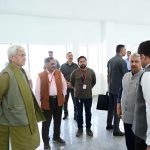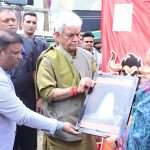There is an ancient story from Purana about King Kakudami and her daughter Revati. According to the story, King Kakudmi, a powerful monarch who ruled Kusasthali, was anxious about finding a suitable groom for her daughter Revati. Kakudmi took Revati with him to Brahmaloka (abode of Brahma) to seek the advice of Lord Bramha about finding a suitable husband for Revati.
When they arrived, Brahma was listening to a musical performance in the company of other celestial beings. So, King Kakudami waited patiently until all the performances finished. Kakudmi bowed humbly, made his request and presented his list of shortlisted names who were great warriors and sought Brahma’s advice. On hearing this Lord Brahma laughed loudly and informed him that time has passed differently on Earth, and all the shortlisted names that he had in mind for Revati’s marriage are now long gone, as several cycles of creation have occurred in the time they were waiting.
Bramha explained that time runs differently on different planes of existence and that during the short time they had waited in Brahmaloka to see him, 27 yugas had passed on Earth and all the shortlisted candidates had died long ago. Brahma added that Kakudmi was now alone as his friends, ministers, servants, wives, kinsmen, armies and treasures had now vanished from Earth and he should soon bestow his daughter to a husband as Kali yuga was near. This story may seem to many as a mythological unless one has seen Christopher Nolan’s cinematic masterpiece “Interstellar”, a science fiction, where the concept of time elasticity takes centre stage, captivating audiences with its portrayal of the relativistic effects of gravity and velocity on the passage of time.
The film follows the journey of a group of astronauts who embark on an interstellar voyage through a wormhole near Saturn in search of a new habitable planet for humanity’s survival. Wonder what a Wormhole is! Let me explain. A wormhole is a theoretical concept in physics that represents a hypothetical tunnel-like structure connecting two separate points in spacetime. It is often depicted as a shortcut or a bridge that could potentially allow for faster-than-light travel or instantaneous transportation between distant locations or galaxies.
The lead character Cooper, in the movie, portrayed by Matthew Mc Conaughey, embarks on a daring journey through space and time to save humanity from extinction. One of the most touching aspects of the narrative is the phenomenon of time dilation, where time passes differently for Cooper and his daughter Murph, played by Mackenzie Foy. As Cooper ventures into the depths of space on the spacecraft, he encounters extreme gravitational forces. This results in time passing much more slowly for him relative to Earth. Meanwhile, back on Earth, Murph ages rapidly, experiencing decades passing in the span of a few years for Cooper.
The narrative in both the cases highlight the concept of time elasticity and its implications for human perception and understanding of reality. The timeless tales of King Kakudami’s journey and the epic journey portrayed in “Interstellar” both serve as touching reminders that time is not a linear construct bound by the constraints of human perception. At the heart of both narratives lies the profound insight that recognition, when transcended, can take a person beyond time, offering glimpses into the timeless essence of existence that transcends the fleeting moments of mortal life. Whether through the spiritual quest of King Kakudami or the journey of the characters in the movie Interstellar, we are reminded of the timeless truths that lie at the heart of human experience –that is the recognition of true self or transcending that self.
In contemporary science the transcendence would mean expanding our understanding of fabric of reality where as in Kashmir Shaivism transcendence would mean to realise higher states of awareness and unity with ultimate beyond individual identity and perception. In such situation consciousness appears to be fluid and elastic that is continuously expanding and contracting. This expansion is based on one’s state of awareness. That is why our ancestors have been advocating to practice meditation that was discovered to facilitate and deepen the level of consciousness.
As individuals deepen their level of consciousness through practices of meditation, mindfulness, or spiritual contemplation, they often experience an expansion of awareness. This expanded awareness can lead to a shift in perception, allowing individuals to perceive time as more fluid and flexible. Rather than being bound by linear time, they may feel a sense of timelessness or interconnectedness with past, present, and future moments as we noticed in case of King Kakudami and the movie Interstellar.
Similarly, Pratibighnya in Kashmir Shaivism, also involves the ability to reflect upon one’s own consciousness in order to recognize and affirm one’s inherent divine nature. It reveals a deep interconnection between self-awareness and expanded states of awareness. This expanded state of consciousness often involves a heightened sense of presence and awareness of the present moment. In this state, individuals may find themselves fully immersed in here and now, free from the constraints of past regrets or future anxieties. This deep presence can create a sense of time dilation, where moments may seem to stretch or contract based on the intensity of one’s experience.
These experiences challenge the conventional notion of time as a linear and objective measure. At the highest levels of consciousness as per Pratibighnya, individuals may transcend the duality of past and future, self and other, and experience a state of non-dual awareness. It is in this state, that time shall be perceived as a continuous flow rather than a series of discrete moments. Past, present, and future merge into a unified whole, and individuals may feel a sense of timelessness or eternal presence.
Some theories within the realm of quantum physics suggest that consciousness plays a fundamental role in shaping the fabric of reality, including the perception of time. According to these theories, consciousness may exist outside of conventional notions of time and space, influencing the probabilistic nature of quantum events. In this view, higher levels of consciousness may offer access to a deeper understanding of the nature of time and its relationship to consciousness.
Donald Hoffman, a cognitive psychologist and professor of cognitive science at the University of California, proposes that our perceptions of reality, including the passage of time, are not accurate representations of an objective external world, but rather are evolved constructs that help us navigate and survive in our environment. He suggests that our perceptions are like a user interface on a computer screen, simplifying and distorting reality to present us with a manageable and useful picture of the world. Hoffman’s theory implies that our subjective experience of time is not a direct reflection of an external, objective timeline but is instead a construct of our consciousness. He suggests that time may be more fluid and malleable than we perceive it to be, with our experiences of past, present, and future being shaped by our cognitive processes rather than by any inherent property of the universe.
In Kashmir Shaivism, time dilation and elasticity can also be linked to this flow of consciousness. Time is seen as a manifestation of Shiva’s energy, constantly expanding and contracting within the universe. This concept seems to align with the idea of wormholes, which are hypothetical tunnels in space-time that could connect distant points in the universe, effectively bending or twisting spacetime to create shortcuts. Shiva is associated with transcendental states of consciousness and mystical experiences. Shiva is often depicted as meditating in deep states of samadhi, symbolizing the attainment of higher levels of awareness and spiritual realization. Wormholes, in a metaphorical sense, could be seen as gateways to higher dimensions or alternate realities, offering access to realms beyond our ordinary perception. Just as Shiva represents the connection to higher realms of consciousness, wormholes represent the possibility of accessing higher dimensions of space-time.
In synthesizing the narratives of the Kakudami story, “Interstellar,” and idealistic philosophy on consciousness, we can contemplate the profound insights that lie at the intersection of ancient wisdom and modern understanding. Across cultures and disciplines, from ancient sages to contemporary thinkers, the recognition of our own divinity and the eternal dance of consciousness remains a guiding principle, offering solace, inspiration, and hope in our quest for truth and self-realization. Through these tales, I become overwhelmed with the timeless wisdom of Pratibignya that is as relevant today as it was thousands of years back, guiding us on a journey of awakening and transformation towards the realization of our true nature as beings of light and love.
It is this flow of our consciousness that makes us to recognise the time dilation and its elasticity. Given that the time is also manifestation of Shiva’s energy that is constantly expanding and contracting, it is the level of our consciousness awareness and level of recognition that we are able to experience this expansion and contraction. In modern physics also, the observer’s consciousness plays a fundamental role in the nature of reality, as suggested by theories like quantum mechanics.
Therefore, Kashmir Shaivism can be also seen as a philosophical precursor to modern ideas like wormholes and the observer effect in quantum mechanics, highlighting the interconnectedness of consciousness, time, and the universe. The convergence of Kashmir Shaivism and quantum physics has immense potential to present a rich and fertile ground for interdisciplinary exploration. Both Kashmir Shaivism and quantum physics delve into the nature of consciousness and its relationship to reality.
While Kashmir Shaivism emphasizes the importance of consciousness as the substratum of existence, quantum physics explores the role of observation and measurement in shaping the behaviour of quantum systems. Investigating the parallels between these perspectives could deepen our understanding of the fundamental nature of consciousness and its role in shaping the fabric of reality. Both Kashmir Shaivism and quantum physics challenge conventional notions of time and space. Kashmir Shaivism suggests a timeless and spaceless reality beyond the limitations of ordinary perception, while quantum physics introduces concepts such as non-locality and time dilation that transcend classical notions of space-time. Exploring the connections between these perspectives could offer new insights into the nature of time, space, and their relationship to consciousness.
Perhaps for scientists it is not sufficient to talk of consciousness unless they mathematically prove it and that is where Donald Hoffman says that for science the “starting point is the experiences and their probabilistic relationship with other experiences that will help mathematically understand this whole philosophy” and therefore build a relationship model with other philosophies including Kashmir Shaivism. For this we need to have more efforts to nurture interdisciplinary studies that can explore bridges between Kashmir Shaivism, neuro science and quantum physics and deepen our understanding of Quantum Consciousness and the nature of existence. By exploring the parallels and intersections between these profound traditions, we can uncover new insights that transcend disciplinary boundaries and contribute to a more holistic understanding of the universe and our place within it.
Kakudami and the film Interstellar, are just indicators of human quest for knowledge, meaning, and transcendence in the face of the vast mysteries of the cosmos and they inspire amazement and wonder at the beauty and complexity of the universe, inviting us to contemplate our place within the cosmic design of existence for which Pratibighnya is the guiding doctrine.
(The Author is Vice Chancellor, Shri Vishwakarma Skill University)








